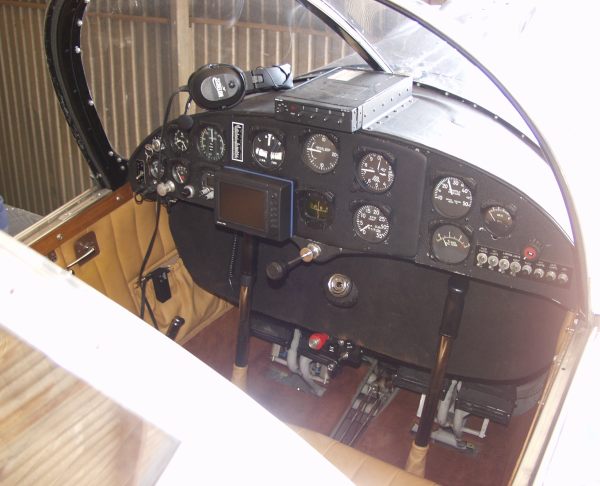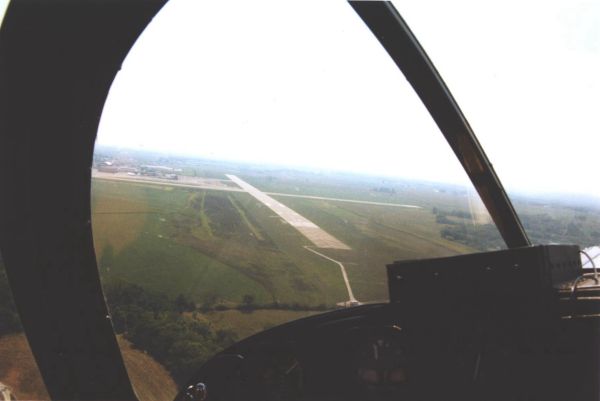The SC-W is one of those rare planes that flies as good as it looks. It is a joy in the air.
Preflight
Preflight begins with a cockpit inspection, reached by climbing up the narrow wingwalk on either side of the fuselage. The canopy is opened by twisting on the handle atop the canopy frame, and it slides back. Inside the cockpit, the first thing to check is the fuel valve, which is buried underneath the fuel tank. The fuel tank is located directly in front of the cabin and above the rudder pedals, just the place to spill fuel in your lap in case of an accident!

While up on the wing, the single fuel tank is visually checked for fuel level. The cap is in the center of the fuselage just in front of the windshield. The fuel gauge seems pretty accurate and is a direct-reading window on the back of the fuel tank, similar to the gauge in an Aeronca Champ.
The remainder of the preflight is pretty standard beyond checking the engine for hydraulic lock by turning over the prop manually. One annoying mis-feature of this airplane is that the cowling has no oil door, so the entire cowling must be opened up to check the oil level. This involves removing 3 screws and undoing the cowling latches at the bottom, then avoiding the oil drips. I plan to add an oil door to the left side of the cowling to alleviate this problem.
Startup and Taxi
Like most Warner-engined aircraft, the Ryan has no impulse couplings for the engine magnetos. This makes starting a little more interesting and a magneto timing retard control is provided to ease the pain. The Ryan usually starts up with three shots of primer, about 1/2 inch of ignition retard, and slight throttle pumping while cranking. After starting it is important to return the magneto timing control to the full advance position or else the engine won't make power.
If the engine kicks back, then there's usually not enough retard so pull out a little further. If there's too much retard applied then the magnetos loose their spark energy and the engine won't start. Generally for a cold start retard helps, and for a warm start it isn't necessary and will often prevent a start until the retard is returned to full advance.
Taxiing is normal for a taildragger. There is a small amount of tailwheel steering on this airplane because the tailwheel has been modified with a steerable linkage. My aircraft has been converted to Cleveland hydraulic disk brakes set up as toe-brakes. The rudder pedal position makes using the toe brakes a little awkward, but it is easier than using the factory equipment which was a Johnson-bar operated brake system that applied brakes in proportion to the rudder deflection towards a given wheel.
Runups are pretty standard. First verify that the speed brake is retracted. The flap lever is located on the lower left cabin wall and it conveniently punches the pilot in the calf when retracted. Warner engines, like most radials, run slower than more modern flat engines, with a redline at 2050 RPM. The runup is performed at about 1700 RPM with magneto and carb heat checks. There are no other instruments to set beyond verifying the altimeter setting and radio/transponder.
If the plane hasn't been flown for 2-3 weeks, generally enough residual oil leaks out that during the runup the exhaust manifold temperatures and rush of air blows the oil onto the manifold and it burns in a cloud of smoke. For the first 30 seconds or so of the runup the canopy can go IFR due to the oil smoke blowing out of the rear of the cowling and into the cockpit through the cabin heat vent (which leaks air). This is a good reason to do the runup with the canopy slightly open, and it is part of the pride of ownership with radial engines.
Takeoff and Climb-out
The takeoff is quite mild, with the tail coming up given slight forward stick and the plane flying off about 50 mph indicated. It will easily fly off from a three-point position. The midpoint trim position tends to result in the plane jumping off and needing some forward stick initially as the aircraft builds speed. Climb-out is at about 70 mph indicated, yielding an initial climb at sea level of about 800 fpm with full fuel and the pilot.
After reaching altitude, cruise requires a fairly nose-down attitude and usually a turn or two of forward trim, which moves relatively slowly. The Ryan does not need much in the way of trim adjustment. Visibility is excellent and speed builds to between 110 and 120 mph depending on the throttle setting.
The prop currently on the airplane is an eight-six inch diameter 69" pitch Sensenich wooden model that is the same as is used on a Fairchild 24, however the Fairchild cruises about 20 mph slower than the Ryan. This propeller appears to be a climb prop on the Ryan, as the engine will make redline during a static runup and at level cruise will overspeed by about 200 RPM at full throttle. A higher-pitch cruise prop is on the list of future modifications.
Once trimmed the SC is very stable in pitch, even in moderate turbulence. It tends to yaw somewhat in turbulence. Overall the SC is a two-finger airplane for straight and level and it engenders confidence.
As fuel burns off the C.G. seems to move rearward by a small amount, and a touch of additional nose down trim is required every half hour or so during long-duration cruise. Also the cruise speed is sensitive to loading. With an aft CG load with cargo in the back seats the speed slows down significantly. This is a bummer for flyins where I'm often carrying a lot of baggage for a long cross country.
Steep turns are easy and the visibility is excellent. The stick feel is light in both roll and pitch and it is very responsive. Power off stalls happen at about 45 indicated with no buffet and a sharp break with a wing drop. Recovery is fast.
One quirk of my engine is that when the oil temperature heats up, the oil pressure will start to occasionally and momentarily dip to 50 psi, then return to its normal 70 psi. It is like the oil pressure gauge is winking at you. This is probably due to the oil pressure relief regulator assembly hanging up, and other Warner engine owners that I've talked to have the same problem. It is just one of those little things that you have to get used to with older airplanes. At the next annual I plan to remove the regulator and see if there any obvious causes such as burrs on the oil pressure relief plunger in the engine.
You can fly with either the canopy open or closed, or slightly open for ventilation. Since the canopy is all plexiglass it gets hot on a sunny day in the summer so partially open is desirable. There is little buffet at the partially open position, but in any position the noise level is very high. Once in flight the canopy is difficult to move due to airloads. To get in and out the canopy is moved by twisting the canopy release lever in the top center and sliding forward or aft. The lever has a locking arm to secure the canopy in the closed position for flying.
Not only do you get plexiglass all around in the canopy baking you, but the polished metal surfaces of the wings and cowling reflect extra sunlight up at the pilot. A required checklist item for the Ryan is a good set of sunglasses. This is particularly important at runrise or sunset where there's a low sun in the sky and it is also reflected off the cowling giving the effect of two suns in the eyes.
In the Pattern and Landings
During the descent the SC speeds up to about 135 mph quite easily, so throttling back is necessary with a fixed pitch prop in order to avoid over-speeding the engine. Nearing the pattern the drag flap is deployed below 106 mph. The drag flap lever on the the sidewall to the left of the pilots seat, with a spring-detent release button on the end of the handle. It is necessary to push the handle forward slightly while pressing the release button to overcome some preload in the mechanism. To deploy the handle is pulled backwards towards the pilot, and to retract the handle is pushed forwards. There is only one fuel tank, so no fuel valve management is needed, and there are no other controls to worry about for the pattern beyond carburetor heat.
When the speed brake deploys it is a noticeable drag but not excessive with only one notch deployed. My plane is currently limited to one notch of flap due to a modification by previous owners. Two or three notches would be helpful for short fields since the aircraft is a bit of a floater. There is no significant trim change when deploying the speed brake.

Cutting power back abeam the numbers on downwind to about 1200 RPM yields a good descent rate for final in a normal-sized pattern. Flying final at 70 mph indicated yields a good descent and reasonable speed. The plane slips easily to lose excessive altitude.
Over the numbers the power is cut. The SC floats quite a ways in most cases but it is very controllable even in a crosswind. The extent of the float means cutting power sooner is better for control. With patience and slowly bleeding back on the stick into a three point attitude the plane settles onto the runway quite nicely. The gear does not produce bounces even if the flare is a little high. I've not noticed any squirreliness on the ground, just a little bit of rudder tap dance. I suspect that with more practice, a slower approach speed, and another notch of drag flap, that the Ryan can be landed very short.
Another Perspective
Here's another perspective by Budd Davisson on flying Brad Larson's SCW, which is a very close twin to my plane. The biggest difference is that Brad's plane has the original Johnson bar brakes.